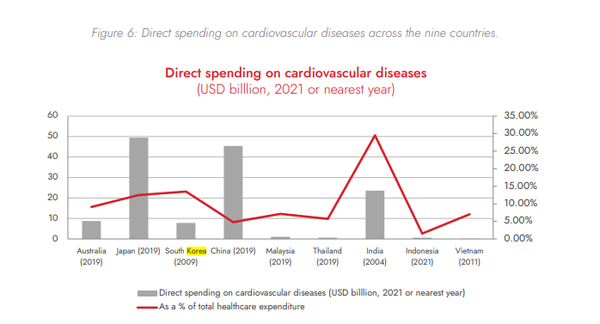In a groundbreaking effort to combat cardiovascular diseases (CVDs) in Asia-Pacific, the Asia-Pacific Cardiovascular Disease Alliance recently released the "A Call for Cohesive Action: Redefining Cardiovascular Care Report," which underscored the region's unique position and ongoing efforts to curb the rising tide of heart disease and related conditions.
Notably, the report outlined Korea's status in combating CVDs along with eight other APAC countries, including Japan, Australia, China, Vietnam, Thailand, Malaysia, India, and Indonesia.
Korea, along with its Asia-Pacific counterparts, faces a daunting task managing the burgeoning burden of CVD amidst aging populations, lifestyle changes, and economic constraints.
The report highlighted Korea's significant strides and the critical areas where further actions are necessary to fortify its healthcare system against the escalating CVD threat.

A closer look at Korea's CVD landscape
The report reveals that similar to its regional neighbors, Korea faces a high prevalence of atrial fibrillation (AF) and other heart diseases, particularly impacting women.
Intriguingly, the country has observed a notable shift in the disease burden, with thrombotic stroke and ischemic heart disease rates climbing despite a decline in hemorrhagic stroke cases.
Korea was the only country where ischemic heart disease (IHD) incidence declined slightly. However, the country's stroke incidence saw the most significant increase (43.8 percent) among the Asia-Pacific countries.
Contributing factors to CVD in Korea encompass dietary risks, high blood pressure, and high LDL cholesterol, which remain the leading culprits behind the disease's prevalence.
However, a silver lining appears as the report notes Korea's downturn in CVD mortality, attributed to improved management and prevention strategies over recent years.

Economic implications and healthcare strain
The report also showed that the economic toll of CVD on Korea is profound, with out-of-pocket expenses for CVD care significantly exceeding recommended limits.
According to the report, in the early 2000s, Korea witnessed a downturn in CVD mortality, attributed to a decline in hemorrhagic stroke cases. However, the burdens of thrombotic stroke and ischemic heart disease began to rise.
"Studies show a substantial factor contributing to the escalation of CVD healthcare costs is the aging population, accounting for more than a 20 percent rise in hospitalization expenses," the report outlined. "According to the Korean Circulation Journal, heart failure cost per patient was $2,357, and heart failure hospitalizations were $10,714 per patient in Korea.
The report stressed that this financial strain is particularly pronounced among households with lower socio-economic status and older individuals with comorbidities, emphasizing the need for more inclusive healthcare financing and support mechanisms.
"Without governments investing in cohesive strategies that tackle prevention, earlier detection, and more effective management of CVD, the costs to individuals, society, and economies will only escalate further," the report said.

Strategic recommendations for Korea
The report applauds Korea for its dedicated CVD strategies, including its 2017 policy efforts, but calls for a more cohesive and comprehensive approach.
"Korea is the only country among the nine countries that has a strong central-subnational coordination in formulating, implementing, and reviewing evidence to refine CVD policies," the report said.
Recommendations include the development of disease-specific targets,, and increased investment in CVD research, prevention, and care.
"Korea also faces difficulties in integrating hospital CVD data with electronic medical records systems," it said.
As Korea and the Asia-Pacific region advance, the report advocates for a health-in-all strategy, emphasizing the integration of CVD prevention into all aspects of public policy and healthcare delivery.
This holistic approach seeks to address upstream risk factors, such as unhealthy diets, physical inactivity, and tobacco use, through multi-sectoral collaborations and community-wide awareness campaigns.
Meanwhile, the APAC CVD Alliance is working towards gathering data, sharing best practices, advocating for improved patient care standards, and promoting research and innovation in the field of cardiovascular diseases.
By publishing such comprehensive reports, the alliance aims to inform and influence policy decisions, healthcare practices, and patient care standards across the Asia-Pacific region, using countries like Korea as benchmarks for success and innovation in cardiovascular care.

